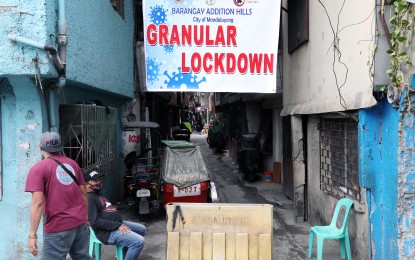
(File photo)
MANILA – Malacañang on Tuesday announced that the guidelines for the pilot implementation of granular lockdowns and alert level system in Metro Manila are “deemed approved” under an already existing executive order.
Presidential Spokesperson Harry Roque made this remark after a new classification framework for Metro Manila, which will be imposed from Sept. 16 to 30, was released on Monday night.
“‘Yan po ay deemed approved under EO 112. Di ko lang po sigurado kung tama nga yung number pero may EO po na nagde-delegate ng kapangyarihan na mag-issue ng ganitong patakaran sa IATF (That is deemed approved under EO 112. I’m just not sure if the number is right but there is an EO delegating the IATF to issue such guidelines),” he said in a Palace press briefing.
Executive Order (EO) 112, inked by President Rodrigo Duterte, implements enhanced community quarantine (ECQ) in high-risk areas and general community quarantine (GCQ) in the rest of the country.
“Maganda rito po, hinahayaan natin magbukas yung mas malaking porsiyento ng ating ekonomiya sa ilalim po ng GCQ. Ibig sabihin po makapagtrabaho ang marami sa ’tin. Hindi pa rin po lahat, pero mas marami po ngayon ang makakapagtrabaho (What’s good about this is that we are allowing a bigger percentage of our economy to open under GCQ. This means many of us can resume work. Not everyone, but more people can resume work),” he added.
Under the new guidelines, the new community quarantine classifications will have five alert levels that would determine the activities allowed in cities and/or municipalities.
These are:
* Alert Level 1 - refers to areas wherein case transmission is low and decreasing, total bed utilization rate, and intensive care unit utilization rate is low.
* Alert Level 2 - refers to areas wherein case transmission is low and decreasing, healthcare utilization is low, or case counts are low but increasing, or case counts are low and decreasing but total bed utilization rate and intensive care unit utilization rate is increasing.
*Alert Level 3 - refers to areas wherein case counts are high and/or increasing, with total bed utilization rate and intensive care unit utilization rate at increasing utilization.
* Alert Level 4 - refers to areas wherein case counts are high and/or increasing, with total bed utilization rate and intensive care unit utilization rate are high.
*Alert Level 5 – refers to areas wherein case counts are alarming, with total bed utilization rate and intensive care unit utilization rate at critical level.
“Areas placed under Alert Level 5 shall observe the guidelines applicable to Enhanced Community Quarantine (ECQ) as provided for under the IATF Omnibus Guidelines on the implementation of Community Quarantine in the Philippines, as amended,” the new guidelines stated.
On Sept. 3, the IATF issued a resolution which provides that under the new classification framework, which focuses on the imposition of granular lockdown measures, community quarantine shall be reduced to either ECQ or general community quarantine (GCQ) “with the latter having an alert level system (Alert Level 1 to 4) with each alert level limiting restrictions only to identified high-risk activities.”
Metro Manila will be placed under GCQ with Alert Level 4 from Sept. 16 to 30, according to Interior Secretary Eduardo Año.
He said the pilot implementation of the alert level system in the capital region will be assessed and it may be recommended to the President for a possible nationwide implementation.
Metro Manila Development Authority (MMDA) Chairman Benhur Abalos said the National Capital Region (NCR) mayors agreed to implement uniform Alert Level 4 during the pilot test of the granular lockdowns and alert level system.
Under Alert Level 4, the following protocols shall be observed:
* Persons below 18 years old and over 65 years of age and with immunodeficiencies, comorbidities or other health risks, and pregnant women shall not be allowed outside;
* Intrazonal and interzonal travel may be allowed subject to the reasonable regulations of the LGU of destination;
* Individual outdoor exercises shall be allowed “but shall be limited within the general area of their residence”;
* Establishments and/or activities characterized as high-risk for transmission shall not be allowed to operate;
* Outdoor or alfresco dine-in services in restaurants and eateries shall be allowed at a maximum of 30 percent venue capacity while indoor dine-in services may be allowed at a limited 10 percent capacity “but will cater only to individuals fully vaccinated against Covid-19”;
* Personal care services limited to barbershops, hair spas, nail spas, and beauty salons shall be allowed at a maximum of 30 percent venue/seating capacity if such services are conducted outdoors regardless of vaccination status. These establishments are allowed to operate at a limited 10 percent indoor;
* In-person religious gatherings shall be allowed at a maximum of 30 percent venue/seating capacity if conducted outdoors regardless of vaccination status. These gatherings may be allowed indoors at a limited 10 percent seating capacity but may accommodate only individuals who are fully vaccinated against Covid-19 in addition to their allowed outdoor capacities;
* Gatherings for necrological services, wakes, inurnment, funerals for those who died of causes other than Covid-19 shall be allowed, provided that the same shall be limited to immediate family members; and,
* Agencies and instrumentalities of the government shall remain to be fully operational and shall adhere to at least 20 percent on-site capacity while applying work-from-home and other flexible work arrangements. (PNA)
